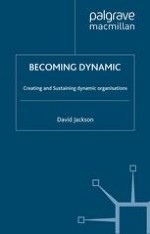2000 | Buch
Über dieses Buch
In this follow-up to the ground-breaking, Dynamic Organisations , David Jackson leads the reader step-by-step through the change management process. He describes the change management process using a unique 'double loop' model and uses this to clarify processes which can otherwise appear intimidating, such as environmental scanning, direction setting, change planning, implementation and sustaining activities. A 'Change in Action' section uses vivid case-studies to show how real organisations have risen to the challenge of sustaining on-going innovation. David Jackson wrote Becoming Dynamic to communicate the lessons he has learnt after many years of working as a consultant with senior managers struggling to make change work in a variety of companies. This is reflected in his spirited and enthusiastic style and his refreshing take on much-discussed issues such as leadership, culture, learning and performance.
Anzeige
